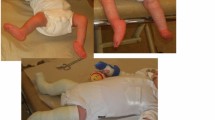Summary
An experimental model has been evolved for provoking dysplasia and dislocation of the hip in autopsy specimens from infants. This was achieved by a constant, submaximal load of 17–32 N acting on the femur for up to 6 h. The test apparatus is described.
For an accurate assessment of the deformation the specimens were frozen at the end of the experiment while still under load. The deformation was then examined by cryodissection and serial cryosectioning. These new techniques are described in detail. As both methods could not be used on the same joint, the experiments had to be specially designed. It is concluded that both unilateral and bilateral loading of the hips seems to be necessary in studies of this kind.
Our methods for provoking and examining dysplasia have proved satisfactory. From the results some conclusions of pathologico-anatomical and clinical interest can be drawn. Dysplasia and dislocation can be provoked by moderate forces acting in 3 to 6 h, without macroscopic damage to the ligaments or capsule. The degree of deformation is related not only to the force but also to the duration of loading.
In some experiments the dysplasia and dislocation provoked were similar to autopsy findings in congenital dislocation of the hip. The methods described would seem suitable for use in similar studies of other joints.
Résumé
Nous avons mis au point un modèle expérimental permettant de réaliser une dysplasie et une luxation de la hanche sur des cadavres d'enfants, grâce à l'application d'une charge maximale de 17 à 32 N sur le fémur pendant 6 h. Nous décrirons l'appareil utilisé pour effecteur le test.
Pour réaliser une évaluation précise de la déformation nous avons congelé les sujets en fin d'expérimentation alors qu'ils étaient toujours soumis à la charge. La déformation a ensuite été analysée par cryodissection et cryosection en série. Ces nouvelles techniques seront décrites en détail. Comme il est impossible d'utiliser les deux méthodes sur la même articulation, les deux techniques ont été effectuées séparément. Ceci nous a permis de conclure que l'étude de charges unilatérale et bilatérale était nécessaire pour un travail de ce type.
Nos méthodes pour provoquer et étudier la dysplasie se sont révélées satisfaisantes et il nous a été possible, à partir des résultats, de tirer des conclusions d'intérêt anatomico-pathologique et clinique. La dysplasie et la luxation peuvent être provoquées par des forces modérées exercées pendant une période de 3 à 6 h sans dommages macroscopiques pour les ligaments ni pour la capsule. Le degré de déformation dépend non seulement de la force exercée mais aussi du temps de la charge.
Dans certaines expériences, la dysplasie et la luxation provoquées étaient identiques à celles trouvées sur des autopsies réalisées sur des sujets présentant une luxation congénitale de hanche. Les méthodes décrites semblent également applicables pour des études similaires sur d'autres articulations.
Similar content being viewed by others
References
Almby B, Hjelmstedt Å, Lönnerholm T (1979) Neonatal hip instability. Reason for failure of early abduction treatment. Acta Orthop Scand 50:315–327
Dunn PM (1969) The influence of the intrauterine environment in the causation of congenital postural deformities, with special reference to congenital dislocation of the hip. M.D. Thesis, Cambridge University
Dunn PM (1969) Congenital dislocation of the hip (CDH): Necropsy studies at birth. Proc R Soc Med 62:1035–1037
Dunn PM (1972) Congenital postural deformities: Perinatal associations. Proc R Soc Med 65:11–14
Dunn PM (1974) Congenital postural deformities. Further perinatal associations. Proc R Soc Med 67:1174–1178
Dunn PM (1976) Perinatal observations on the etiology of congenital dislocation of the hip. Clin Orthop 119:11–22
Galante JO (1967) Tensile properties of the human lumbar annulus fibrosus. Acta Orthop Scand (Suppl) 100
Hjelmstedt Å, Olofsson H, Asplund S (1981) Tensile testing of human ligaments. International Series on Biomechanics, Volume 3 A, Biomechanics 7 B, University Park Press, Baltimore. pp 32–37
Michelsson JE, Langenskiöld A (1972) Dislocation or subluxation of the hip. Regular sequels of immobilization of the knee in extension in young rabbits. J Bone Joint Surg [Am] 54:1177–1186
Noyes FR, Grood ES (1976) The strength of the anterior cruciate ligament in human and rhesus monkeys. Age related and species-related changes. J Bone Joint Surg [Am] 58:1074–1082
Ortolani M (1948) La lussazione congenita dell'anca-nuovi criteri diagnostici e profilatico-corretivi. Capelli, Bologna
Ortolani M (1976) Congenital hip dysplasia in the light of early and very early diagnosis. Clin Orthop 119:6–10
Ponseti JV (1978) Morphology of the acetabulum in congenital dislocation of the hip. J Bone Joint Surg [Am] 60:586–599
Rauschning W (1979) Popliteal cysts and their relation to the gastrocnemio-semimembranosus bursa. Studies on the surgical and functional anatomy. Acta Orthop Scand (Suppl) 179
Stanisavljevic S, Mitchell L (1963) Congenital dysplasia, subluxation and dislocation of the hip in stillborn and newborn infants. An anatomical-pathological study. J Bone Joint Surg [Am] 45:1147–1158
Ullberg S (1977) The technique of whole body autoradiography. Cryosectioning of large specimens. Science Tools, Special issue
Viidik A, Sandqvist L, Mägi ML (1965) Influence of post mortal storage on tensile strength characteristics and histology of rabbit ligaments. Acta Orthop Scand (Suppl) 79
Wroblewski R, Edström L, Rauschning W (1980) Histochemical and X-ray microanalytical investigations of defined organs and cells in their true position within whole-body cryosections. Histochemistry 67:43–52
Author information
Authors and Affiliations
Rights and permissions
About this article
Cite this article
Hjelmstedt, Å., Asplund, S. & Rauschning, W. Cryodissection and cryosectioning in biomechanical studies on congenital dislocation of the hip. Anat. Clin 4, 13–21 (1982). https://doi.org/10.1007/BF01811185
Issue Date:
DOI: https://doi.org/10.1007/BF01811185




